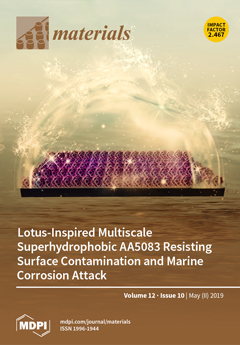The aim of the study was to evaluate the performance of six commercially available universal dental adhesives: Adhese Universal (ADU), All-Bond Universal (ABU), Clearfil Universal Bond Quick (CBQ), G-Premio Bond (GPB), Prelude One (PRO) and Scotchbond Universal (SBU). The properties tested were: (a)
[...] Read more.
The aim of the study was to evaluate the performance of six commercially available universal dental adhesives: Adhese Universal (ADU), All-Bond Universal (ABU), Clearfil Universal Bond Quick (CBQ), G-Premio Bond (GPB), Prelude One (PRO) and Scotchbond Universal (SBU). The properties tested were: (a) degree of C=C conversion (DC%); (b) Vickers micro-hardness (VHN); (c) extent of oxygen inhibition (OI/μm), all related with the adhesive film properties; (d) extent of dentin demineralisation (DM%), insoluble salt formation (AS%); and (e) shear bond strength (SBS, self-etch mode) related to the adhesive-dentin interactions. Statistical analysis (α = 0.05) was performed by one-way ANOVA and Tukey’s test (DC%, VHN, OI, DM% AS%) and Weibull analysis (SBS,
σ0-β). The DC ranged from 67.2–82.5% (all >GPB), OI from 5.6–18.6 μm (SBU > ADU, GPB, ABU > CBQ > PRO), microhardness from 1.1–6.6 VHN (SBU > ADU > ABU > CBQ > PRO > GPB: not measurable), DM from 69.3% (GPB) to 16–12.5% (CBQ, SBU, ADU) and 13.2–10.6% (ABU, ADU, PRO), in homogeneous groups and AS from 26–15.9% (ABU, CBQ > GPB, PRO, ADU, SBU). For SBS the
σ0 (characteristic life) ranged from 29.3–16.6 MPa (CBQ, ADU, ABU, SBU > PRO > GPB), the
β (reliability) from 5.1–9.7 (
p > 0.05). All failure modes were of mixed type (adhesive and composite cohesive). Although all these adhesives were based on the 10-methacryloyloxydecyl dihydrogen phosphate (10-MDP) adhesive monomer, the different co-monomers, solvents and catalysts led to variations in their film properties, reactivity and bonding capacity with dentin.
Full article






